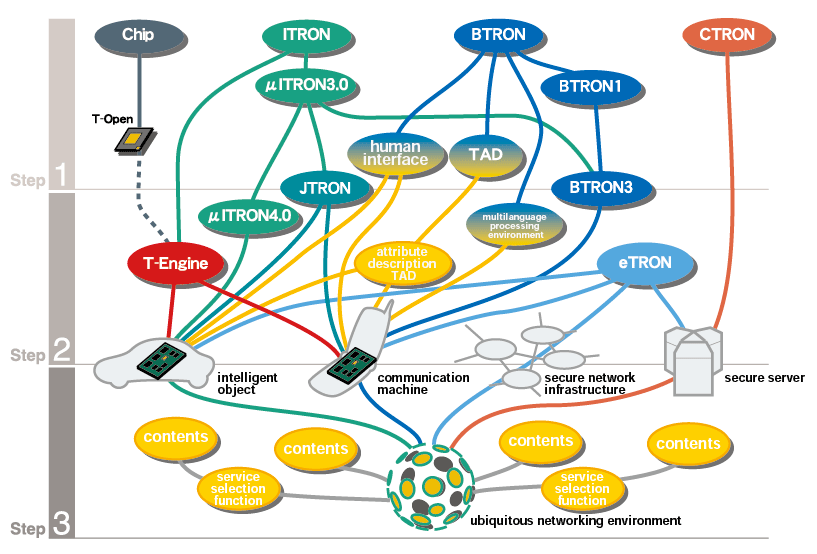What is TRON?
TRON(*) Project is a development project of real-time architecture for embeded systems, and was launched in 1984. The above architecture has been created based on the "open-architecture" philosophy assuring the release and use of every technical information. The development project, led by Ken Sakamura, Professor of The University of Tokyo, is advanced through academic-industry partnership.
The architecture, the achievement of this project, has been widely used in embedded systems in various industries ranging from consumer products to industrial products. The consumer products include automotive engine controls and information appliances such as digital cameras and mobile phones, whereas the industrial products include the machine-control system at a factory.
T-Engine Project started in 2002 for the purpose of supporting new applications emerged in the 21st century. The project was held based on the existing TRON project technology having proven performance for 20 years or more in the embedded field, by conducting a comprehensive survey of the previous achievements and eliminating the weak points.
TRON Project has been promoting the architecture since it's start by highlighting "open architecture." Computer based on open architecture is embedded into any machine, and achieves the ubiquitous networking environment that supports our lives. T-Engine, the newest achievement of TRON Project, is also produced based on the concept of open architecture.
Why is open architecture helpful?
Availability (Openness) of any technical information accelerates many companies to work on TRON Project freely, and therefore new technology can be created quickly. Because it promotes the transition from the existing vertical integration-type development model to the horizontal affiliation-type development model by specifying an open architecture infrastructure as an infrastructure for product development.
T-Engine: open specification and open source code
T-Kernel source code is released in its entire source code, and can be copied and modified. Modified part of T-Kernel can be kept confidential. These concepts are compiled in the license agreement called T-License.
International Standardization
In addition to making open specification and open source code available, TRON project actively suggests standard specification to international standardization associations such as ITU and ISO, and contributes to the international standardization of the infrastructure technology.
Open × Open = ∞ (Infinity)
TRON Project has proposed and promoted openness since its inception. Recently, many technology projects in addition to TRON Project have made their achievements public. TRON Project has been accelerating the realization of ubiquitous computing environment by collaborating with such open technology projects.
Comparison with other RTOSs
IEEE is the world's largest professional society in the field of electricity and electronics with its headquarters in U.S.A. An article in IEEE MICRO, a magazine focusing on computers, gives an overview of RTOSs by comparing several popular RTOSs including μITRON, and μT-Kernel. It has a list of references. Its abstract is quoted below.
"Real-time operating systems have gained popularity in microcontroller- and processor-based embedded system design. This article discusses differences between RTOSs and generic operating systems, the advantages and disadvantages of using RTOSs for small microcontroller system development, and the benchmarking methods used for RTOSs. Benchmarking results for four RTOSs show no clear winner, with each RTOS performing better on some criteria than others."
If you are interested, refer to the following article:
http://dx.doi.org/10.1109/MM.2009.86
http://ieeexplore.ieee.org/xpl/articleDetails.jsp?arnumber=5325154
(You need to have the access right to Computer Society's digital archive to read the full article, but the abstract and the reference list are available to everybody.)
(*) TRON stands for The Real-time Operating system Nucleus.

